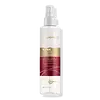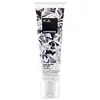What's inside
What's inside
 Key Ingredients
Key Ingredients

No key ingredients
 Benefits
Benefits

 Concerns
Concerns

 Ingredients Side-by-side
Ingredients Side-by-side

Water
Skin ConditioningCyclopentasiloxane
EmollientDimethicone
EmollientC12-15 Alkyl Benzoate
AntimicrobialCinnamidopropyltrimonium Chloride
PEG/PPG-15/15 Dimethicone
EmulsifyingKeratin
Skin ConditioningHydrolyzed Keratin
HumectantLaurdimonium Hydroxypropyl Hydrolyzed Keratin
Skin ConditioningAvena Sativa Peptide
Skin ConditioningArginine Hcl
Skin ConditioningArginine
MaskingRosa Canina Fruit Oil
EmollientArgania Spinosa Kernel Oil
EmollientSchinziophyton Rautanenii Kernel Oil
EmollientHydrolyzed Keratin Pg-Propylmethylsilanediol
Skin ConditioningAllantoin
Skin ConditioningAloe Barbadensis Leaf Juice
Skin ConditioningPhosphatidylcholine
EmulsifyingButyl Methoxydibenzoylmethane
UV AbsorberOenothera Biennis Oil
EmollientCocodimonium Hydroxypropyl Hydrolyzed Keratin
Skin ConditioningPsidium Guajava Fruit Extract
AstringentAleurites Moluccanus Seed Oil
Skin ConditioningThioctic Acid
AntioxidantGlycolipids
Skin ConditioningTocopheryl Acetate
AntioxidantHydrogenated Castor Oil/Sebacic Acid Copolymer
EmollientDipropylene Glycol
HumectantPolysorbate 20
EmulsifyingC10-40 Isoalkylamidopropylethyldimonium Ethosulfate
PEG-40 Hydrogenated Castor Oil
EmulsifyingCetrimonium Chloride
AntimicrobialCocamidopropyl Betaine
CleansingPolyquaternium-11
Sodium Hyaluronate
HumectantCitric Acid
BufferingTetrasodium EDTA
Polysilicone-19
Glycerin
HumectantPolyquaternium-55
Sodium Ascorbyl Phosphate
AntioxidantAminomethyl Propanol
BufferingCaprylhydroxamic Acid
1,2-Hexanediol
Skin ConditioningPropanediol
SolventPhenoxyethanol
PreservativeSodium Benzoate
MaskingBenzyl Alcohol
PerfumingBenzoic Acid
MaskingHydroxycitronellal
PerfumingLinalool
PerfumingAlpha-Isomethyl Ionone
PerfumingCoumarin
PerfumingCinnamyl Alcohol
PerfumingParfum
MaskingWater, Cyclopentasiloxane, Dimethicone, C12-15 Alkyl Benzoate, Cinnamidopropyltrimonium Chloride, PEG/PPG-15/15 Dimethicone, Keratin, Hydrolyzed Keratin, Laurdimonium Hydroxypropyl Hydrolyzed Keratin, Avena Sativa Peptide, Arginine Hcl, Arginine, Rosa Canina Fruit Oil, Argania Spinosa Kernel Oil, Schinziophyton Rautanenii Kernel Oil, Hydrolyzed Keratin Pg-Propylmethylsilanediol, Allantoin, Aloe Barbadensis Leaf Juice, Phosphatidylcholine, Butyl Methoxydibenzoylmethane, Oenothera Biennis Oil, Cocodimonium Hydroxypropyl Hydrolyzed Keratin, Psidium Guajava Fruit Extract, Aleurites Moluccanus Seed Oil, Thioctic Acid, Glycolipids, Tocopheryl Acetate, Hydrogenated Castor Oil/Sebacic Acid Copolymer, Dipropylene Glycol, Polysorbate 20, C10-40 Isoalkylamidopropylethyldimonium Ethosulfate, PEG-40 Hydrogenated Castor Oil, Cetrimonium Chloride, Cocamidopropyl Betaine, Polyquaternium-11, Sodium Hyaluronate, Citric Acid, Tetrasodium EDTA, Polysilicone-19, Glycerin, Polyquaternium-55, Sodium Ascorbyl Phosphate, Aminomethyl Propanol, Caprylhydroxamic Acid, 1,2-Hexanediol, Propanediol, Phenoxyethanol, Sodium Benzoate, Benzyl Alcohol, Benzoic Acid, Hydroxycitronellal, Linalool, Alpha-Isomethyl Ionone, Coumarin, Cinnamyl Alcohol, Parfum
Water
Skin ConditioningDimethicone
EmollientSorbitol
HumectantPropylene Glycol
HumectantBehenyl Alcohol
EmollientStearyl Alcohol
EmollientBehentrimonium Chloride
PreservativeCetyl Alcohol
EmollientHelianthus Annuus Seed Oil
EmollientAloe Barbadensis Leaf Juice
Skin ConditioningAlgae Extract
EmollientPhyllanthus Emblica Fruit Extract
HumectantMacrocystis Pyrifera Extract
Skin ConditioningGlyceryl Oleate
EmollientSteartrimonium Chloride
PreservativePEG-40 Hydrogenated Castor Oil
EmulsifyingPEG-4 Laurate
EmulsifyingPEG-6 Methyl Ether Dimethicone
EmulsifyingPEG-90m
Emulsion StabilisingPPG-26-Buteth-26
Skin ConditioningEthylhexyl Methoxycinnamate
UV AbsorberButyl Methoxydibenzoylmethane
UV AbsorberEthylhexyl Salicylate
UV AbsorberDisodium EDTA
Glycerin
HumectantAminopropyl Dimethicone
Silicone Quaternium-16
Skin ConditioningUndeceth-11
EmollientUndeceth-5
EmulsifyingButyloctanol
HumectantSodium Citrate
BufferingIsopropyl Alcohol
SolventSodium Hydroxide
BufferingCitric Acid
BufferingIodopropynyl Butylcarbamate
PreservativePhenoxyethanol
PreservativeParfum
MaskingBenzyl Salicylate
PerfumingCoumarin
PerfumingGeraniol
PerfumingLimonene
PerfumingLinalool
PerfumingWater, Dimethicone, Sorbitol, Propylene Glycol, Behenyl Alcohol, Stearyl Alcohol, Behentrimonium Chloride, Cetyl Alcohol, Helianthus Annuus Seed Oil, Aloe Barbadensis Leaf Juice, Algae Extract, Phyllanthus Emblica Fruit Extract, Macrocystis Pyrifera Extract, Glyceryl Oleate, Steartrimonium Chloride, PEG-40 Hydrogenated Castor Oil, PEG-4 Laurate, PEG-6 Methyl Ether Dimethicone, PEG-90m, PPG-26-Buteth-26, Ethylhexyl Methoxycinnamate, Butyl Methoxydibenzoylmethane, Ethylhexyl Salicylate, Disodium EDTA, Glycerin, Aminopropyl Dimethicone, Silicone Quaternium-16, Undeceth-11, Undeceth-5, Butyloctanol, Sodium Citrate, Isopropyl Alcohol, Sodium Hydroxide, Citric Acid, Iodopropynyl Butylcarbamate, Phenoxyethanol, Parfum, Benzyl Salicylate, Coumarin, Geraniol, Limonene, Linalool
Alternatives
Ingredients Explained
These ingredients are found in both products.
Ingredients higher up in an ingredient list are typically present in a larger amount.
Aloe Barbadensis Leaf Juice comes from leaves of the aloe plant. Aloe Barbadensis Leaf Juice is best known for helping to soothe sunburns. It is also anti-inflammatory, moisturizing, antiseptic, and can help heal wounds.
Aloe is packed with good stuff including Vitamins A, C, and E. These vitamins are antioxidants, which help fight free-radicals and the damage they may cause. Free-radicals are molecules that may damage your skin cells, such as pollution.
Aloe Barbadensis Leaf Juice also contains sugars. These sugars come in the form of monosaccharides and polysaccharides, folic acid, and choline. These sugars are able to help bind moisture to skin.
It also contains minerals such as calcium, 12 anthraquinones, fatty acids, amino acids, and Vitamin B12.
Learn more about Aloe Barbadensis Leaf JuiceAlso known as Avobenzone, this ingredient is a chemical sunscreen filter that provides protection in the UV-A range.
Avobenzone is globally approved and is the most commonly used UV-A filter in the world.
Studies have found that avobenzone becomes ineffective when exposed to UV light (it is not photostable; meaning that it breaks down in sunlight). Because of this, formulations that include avobenzone will usually contain stabilizers such as octocrylene.
However, some modern formulations (looking at you, EU!) are able to stabilize avobenzone by coating the molecules.
Avobenzone does not protect against the UV-B range, so it's important to check that the sunscreen you're using contains other UV filters that do!
The highest concentration of avobenzone permitted is 3% in the US, and 5% in the EU.
Learn more about Butyl MethoxydibenzoylmethaneCitric Acid is an alpha hydroxy acid (AHA) naturally found in citrus fruits like oranges, lemons, and limes.
Like other AHAs, citric acid can exfoliate skin by breaking down the bonds that hold dead skin cells together. This helps reveal smoother and brighter skin underneath.
However, this exfoliating effect only happens at high concentrations (20%) which can be hard to find in cosmetic products.
Due to this, citric acid is usually included in small amounts as a pH adjuster. This helps keep products slightly more acidic and compatible with skin's natural pH.
In skincare formulas, citric acid can:
While it can provide some skin benefits, research shows lactic acid and glycolic acid are generally more effective and less irritating exfoliants.
Most citric acid used in skincare today is made by fermenting sugars (usually from molasses). This synthetic version is identical to the natural citrus form but easier to stabilize and use in formulations.
Read more about some other popular AHA's here:
Learn more about Citric AcidCoumarins are a group of substances found naturally in plants. There are over 1300 types of coumarins identified. It has a natural vanilla scent.
Coumarin is an identified EU known allergy, meaning it may cause an allergic reaction when applied to the skin.
In many countries, coumarin is banned as a food additive. However, it can be found in soaps, tobacco products, and some alcohol drinks.
Plants use coumarins as a chemical defense. Some plants that have coumarins include lavender, tonka beans, and yellow clovers.
Learn more about CoumarinDimethicone is a type of synthetic silicone created from natural materials such as quartz.
What it does:
Dimethicone comes in different viscosities:
Depending on the viscosity, dimethicone has different properties.
Ingredients lists don't always show which type is used, so we recommend reaching out to the brand if you have questions about the viscosity.
This ingredient is unlikely to cause irritation because it does not get absorbed into skin. However, people with silicone allergies should be careful about using this ingredient.
Note: Dimethicone may contribute to pilling. This is because it is not oil or water soluble, so pilling may occur when layered with products. When mixed with heavy oils in a formula, the outcome is also quite greasy.
Learn more about DimethiconeGlycerin is already naturally found in your skin. It helps moisturize and protect your skin.
A study from 2016 found glycerin to be more effective as a humectant than AHAs and hyaluronic acid.
As a humectant, it helps the skin stay hydrated by pulling moisture to your skin. The low molecular weight of glycerin allows it to pull moisture into the deeper layers of your skin.
Hydrated skin improves your skin barrier; Your skin barrier helps protect against irritants and bacteria.
Glycerin has also been found to have antimicrobial and antiviral properties. Due to these properties, glycerin is often used in wound and burn treatments.
In cosmetics, glycerin is usually derived from plants such as soybean or palm. However, it can also be sourced from animals, such as tallow or animal fat.
This ingredient is organic, colorless, odorless, and non-toxic.
Glycerin is the name for this ingredient in American English. British English uses Glycerol/Glycerine.
Learn more about GlycerinLinalool is a fragrance and helps add scent to products. It's derived from common plants such as cinnamon, mint, citrus, and lavender.
Like Limonene, this ingredient oxidizes when exposed to air. Oxidized linalool can cause allergies and skin sensitivity.
This ingredient has a scent that is floral, spicy tropical, and citrus-like.
Learn more about LinaloolParfum is a catch-all term for an ingredient or more that is used to give a scent to products.
Also called "fragrance", this ingredient can be a blend of hundreds of chemicals or plant oils. This means every product with "fragrance" or "parfum" in the ingredients list is a different mixture.
For instance, Habanolide is a proprietary trade name for a specific aroma chemical. When used as a fragrance ingredient in cosmetics, most aroma chemicals fall under the broad labeling category of “FRAGRANCE” or “PARFUM” according to EU and US regulations.
The term 'parfum' or 'fragrance' is not regulated in many countries. In many cases, it is up to the brand to define this term.
For instance, many brands choose to label themselves as "fragrance-free" because they are not using synthetic fragrances. However, their products may still contain ingredients such as essential oils that are considered a fragrance by INCI standards.
One example is Calendula flower extract. Calendula is an essential oil that still imparts a scent or 'fragrance'.
Depending on the blend, the ingredients in the mixture can cause allergies and sensitivities on the skin. Some ingredients that are known EU allergens include linalool and citronellol.
Parfum can also be used to mask or cover an unpleasant scent.
The bottom line is: not all fragrances/parfum/ingredients are created equally. If you are worried about fragrances, we recommend taking a closer look at an ingredient. And of course, we always recommend speaking with a professional.
Learn more about ParfumPeg-40 Hydrogenated Castor Oil is derived from castor oil and polyethylene glycol (PEG). It is used as a emollient and emulsifier.
As an emulsifier, it helps prevent ingredients from separating. It also helps make the other ingredients more soluble; it is often used to solubilize fragrances. This increases spreadability and elongates shelf life in a product.
Emollients help soothe and soften the skin. They do this by creating a protective film on your skin. This barrier helps trap moisture and keeps your skin hydrated. Emollients may be effective at treating dry or itchy skin.
This ingredient may or may not be vegan, depending on the source.
Peg-40 Hydrogenated Castor Oil may not be fungal-acne safe. We recommend speaking with a professional if you have any questions or concerns.
Learn more about PEG-40 Hydrogenated Castor OilPhenoxyethanol is a preservative that has germicide, antimicrobial, and aromatic properties. Studies show that phenoxyethanol can prevent microbial growth. By itself, it has a scent that is similar to that of a rose.
It's often used in formulations along with Caprylyl Glycol to preserve the shelf life of products.
Water. It's the most common cosmetic ingredient of all. You'll usually see it at the top of ingredient lists, meaning that it makes up the largest part of the product.
So why is it so popular? Water most often acts as a solvent - this means that it helps dissolve other ingredients into the formulation.
You'll also recognize water as that liquid we all need to stay alive. If you see this, drink a glass of water. Stay hydrated!
Learn more about Water